Wargaming The Battle Of The Bulge Part One
December 15, 2014 by crew
December 16, 2014 marks the 70th anniversary of one of the most well-known and controversial battles of the Second World War. The battle stirs debate to this day, sometimes over its very name. But whether you call it Operation “Christrose,” Operation “Wacht am Rhein,” the Ardennes Offensive, or the Rundstedt Offensive, its most famous title remains the one bestowed by the Americans who bore the brunt of its fury. They simply called it the Battle of the Bulge.
A Step Back In History
To commemorate the anniversary, our gaming group is running a series of wargames recreating some of the Bulge’s more decisive moments. For close-up views of small engagements, I have teamed with Beast of War community member Gladesrunner for “hexless” Axis and Allies 15mm miniature games (Wizards of the Coast). For the broader, operational-scale view of colonels and brigadier-generals, I have teamed up with community member and veteran wargamer Amphibiousmonster for games run in a modified version of Avalon Hill’s classic “Panzer Leader.” The objective of this article series is to take a look at the Battle of the Bulge through a wargamer’s eye, hopefully blending history and gaming for best results.
The Battle of the Bulge (so named for the huge bulge it pressed in Allied lines) remains the largest and bloodiest land engagement ever fought by the United States (over 90,000 total casualties, with over 20,000 killed). Because the Americans entered the war relatively late, this is probably the only time they felt the fury of a full German blitzkrieg, and got just a small taste of what the UK, France, and the Soviet Union experienced during the war’s early days.
The time was December, 1944...deep in the misty, snow-bound frost of the war’s last winter. The Normandy landings had taken place six months before. Since then, American, British, Canadian, and French armies had liberated Paris and pushed to the western German border. There they were stalled by the weather, exhaustion, logistical difficulties, the Rhine River, and German defences of the Siegfried Line.
Hitler had resolved to make the most of this reprieve, and directed his generals to mass the bulk of the Reich’s remaining reserves in preparation for a surprise attack on the weakest point of the Allied line. This was the Ardennes region along the German-Belgian border, a heavily-forested and hilly region held by just four understrength American divisions. Curling northward, the Germans would strike for Antwerp, the key Belgian port that was currently the Allies’ main base of supply. Such a strike could also split most of the American armies in the south from their British and Canadian allies in the north.
The scale of the German preparation was incredible, especially considering that they’d been on the losing end of World War 2 for almost three years. Three German armies (6th Panzer, 5th Panzer, and the 7th) had gathered together no less than 26 divisions, many of them the best units Germany had left. Many of these formations were lavishly equipped with weapons like the “Königstiger” heavy tank and the new “Sturmgewehr” StG-44, the world’s first assault rifle. The mobilization was made with masterful secrecy, despite complete Allied control of the air. Units never moved in daylight, officers never travelled with written copies of the orders, deployments were never directed by radio, and the strictest discipline was enforced with camouflage. By the middle of December almost a quarter million troops and thousands of tanks were at their jump-off points, and generally speaking, the Americans didn’t have a clue.
There were many reasons American commanders assumed they were safe. While battles like Market-Garden, Arracourt, and the Hürtgen Forest proved that German divisions could still mount bitter resistance and ferocious local counter-attacks, the idea of a large, operational-scale German offensive seemed far-fetched. Also, the Ardennes seemed the last place for anyone would launch a mechanized attack. Woods, hills, narrow roads, and numerous rivers crossed by only tiny bridges, all combined to make the Ardennes the worst “tank country” ever. Accordingly, the Ardennes was viewed by the Americans as a “quiet” sector of the line, where newly-arrived units were eased into front-line life and battered units could rest and train replacements.
But it was through this very same “unlikely place” that the Germans launched their successful blitzkrieg in 1940, defeating the French and British in a campaign that conquered most of Western Europe. The Americans forgot this, but at 05:30 on December 16, 1944...
...the Germans reminded them.
ENGAGEMENT ONE: BITTER DEFENSE AT KRINKELT-ROCHERATH - DEC 16, 1944
So let’s get gaming.
Our first game recreated part of the opening German onslaught, which tore into stunned American lines during the first hours of the battle. Using 15mm Axis and Allies miniatures, I took command of elements of the 12th SS Panzergrenadier Division, trying to break through positions held by Gladesrunner’s units of the US 99th Infantry Division. This fight took place near the tiny Belgian villages of Krinkelt and Rocherath, in the northern shoulder of the German breakthrough zone. The 6th Panzer Army had to take these towns and their roads in order to start their planned northward pivot toward the Meuse River and ultimately Antwerp.
The first step was to build our forces. When playing a truly historical battle, the first thing you have to do is dump any notions of “army lists” or “points.” Your list is what was there, translated into whatever gaming system you’re using. While this will yield some very unbalanced battles (war is never fair), you can make a fair game out of an unfair battle through careful construction of victory conditions. Basically, if you can take what was on the field that day and do better than your historical counterpart...you win. Needless to say, this approach to gaming requires a great deal of in-depth research.
The 12th SS Division was named “Hitlerjugend” (Hitler Youth), after the organization from which many of the men were drawn. But these were no Boy Scouts. By this point in the war they were hardened soldiers, ferociously loyal and and lavishly equipped, with plenty of experience ripping apart British and Canadian formations in the Normandy battles around Caen the previous June.
In contrast, Gladesrunner fielded elements of 99th US Infantry Division. This formation had only just arrived at the front, with so little experience that the unit was nicknamed the “Battle Babies.” Game units included rifle squads, plenty of bazooka teams, halftracks, trucks, and 81mm mortars, all representing about 200 men of the 393rd Infantry Regiment. The Americans also had one M-10 Wolverine of the 801st Tank Destroyer Battalion (attached), but their real firepower came from the 75mm and 105mm howitzer batteries of the 370th Field Artillery Regiment.
Despite this disparity of forces, the German attack was frustrated by skilful deployment of American forces, especially the bazookas and 76mm towed antitank guns. The terrain didn’t help, not to mention the tough victory conditions (I had to get at least three vehicles off the American edge of the map table by the end of Turn 7). Gladesrunner ensured that this was NOT an easy fight. In the end, I was only able to get two vehicles off, resulting in a narrow German defeat.
ENGAGEMENT TWO: ARMOUR IN THE DEFENCE 7TH ARMOURED AT ST. VITH - DEC 17, 1944
Our next battle is a little more famous. In fact, it’s still used in some military academies as an example of how to use armour not in its traditional role of attack, but in defence. The location was the Belgian town of St. Vith, many of the roads in 5th Panzer Army’s axis of advance initially converged. This made taking St. Vith absolutely crucial for 5th Panzer Army’s commander, General Hasso von Manteuffel.
At first, German spearheads made solid progress toward St. Vith. On the first day of the offensive, the Germans tore into the brave but hopelessly outmatched 106th Infantry (The Golden Lions), another brand-new division recently arrived from the States. Both wings of the 106th collapsed and two of the division’s three rifle regiments were surrounded, forcing one of largest surrenders of American soldiers in World War 2. The remnants of the 106th fell back to St. Vith, where they joined with the newly arrived US 7th Armoured Division. Here the Germans were slammed to a halt on December 17, sparking a furious battle for St. Vith that would rage for almost a week.
We wanted to take a larger view of this fight, so Amphibiousmonster and I went head-to-head in a game of Avalon Hill’s “Panzer Leader.” In this game, each counter represents a either a platoon (five tanks or 50-60 men) or a battery of artillery, depending on the historical organization of the armies in question. Thus, we could field forces totalling anywhere from 1,000 to 3,000 men. Each hex is 250 meters across, covering a square area typically encompassed by three or four Bolt Action tables.
Like most American armoured divisions of the period, the 7th Armoured (Brigadier-General Hasbrouck) was organized into three “combat commands,” temporary regiment- or brigade-sized formations tailored to specific missions. At St. Vith we had Combat Command B, or “CCB,” reinforced by artillery assets attached from Corps (the 270th Field Artillery Regiment) and the remnants of the 106th Infantry. These survivors included the 81st Engineer Battalion, which would acquit itself well at St. Vith and inflict plenty of revenge for the rest of its unfortunate division. To build out CCB/7th Armoured, Amphibiousmonster fielded the 31st Tank Battalion, the 38th Armoured Infantry in M3 halftracks, and the 87th Armoured Recon Battalion in M8 and M20 armoured cars.
In our game, the Americans again held the line, albeit only after taking horrific losses. As the German commander, I managed a small foothold in the outskirts of St. Vith, but not enough to win the game. Another turn or two might have turned the tables, but I didn’t crack St. Vith in the time allowed, reflecting how the rest of the German operation starts to come unstuck thanks to my sluggishness.
Such was roughly the story with St. Vith historically. The stubborn American defence of this town and its vital road network meant that the whole German right wing bogged down. This was supposed to be the main punch of the Ardennes Offensive, but now this area of emphasis had to be shifted further south...toward a historic rendezvous with another small Belgian town named Bastogne.
Of course, the Battle of the Bulge was only just beginning. In future articles we’ll take further looks at this epic campaign, and how to bring it to the table top.
If you would like to write an article for Beasts of War then please contact me at [email protected].
"Basically, if you can take what was on the field that day and do better than your historical counterpart...you win"
Supported by (Turn Off)
Supported by (Turn Off)
"Of course, the Battle of the Bulge was only just beginning..."
Supported by (Turn Off)


































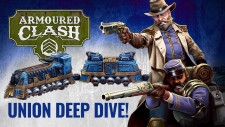






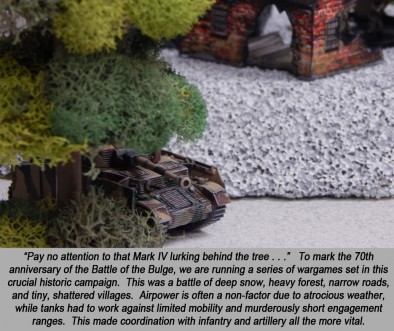
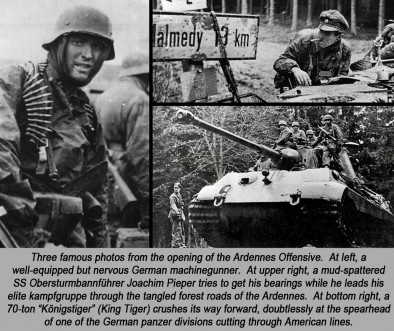
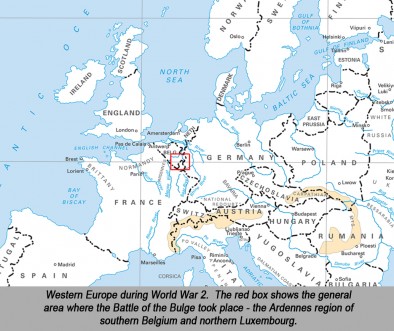
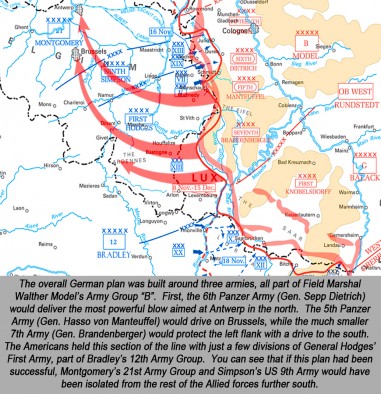
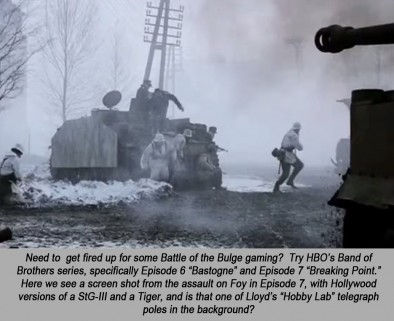
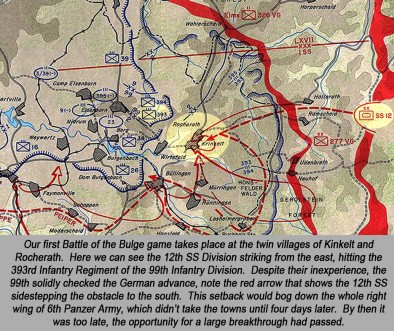
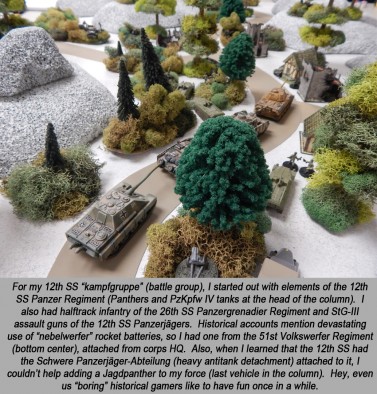
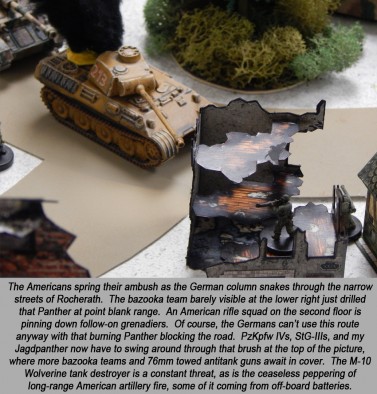
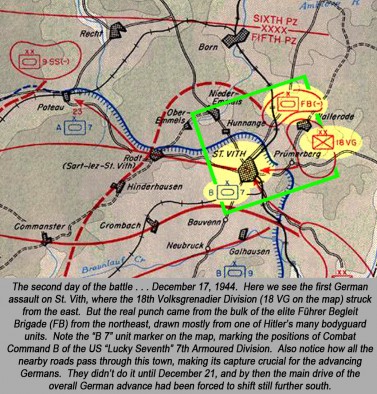
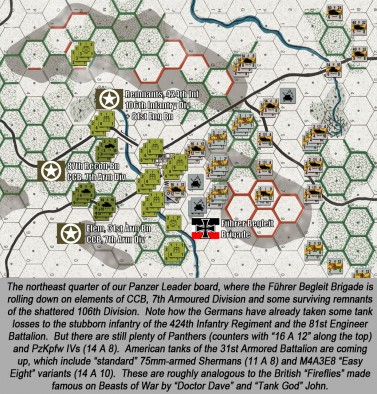
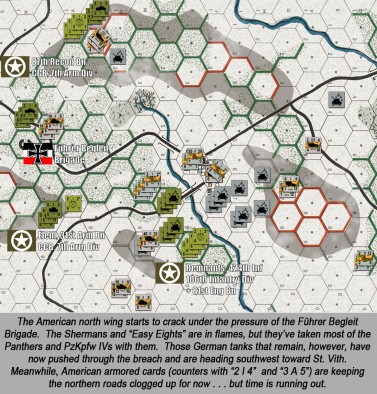
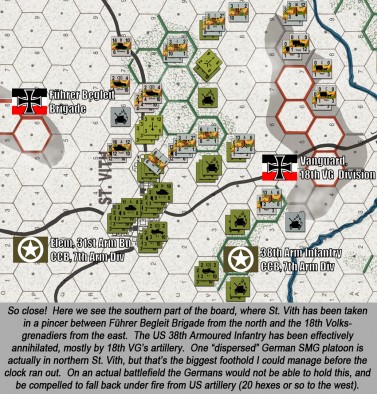


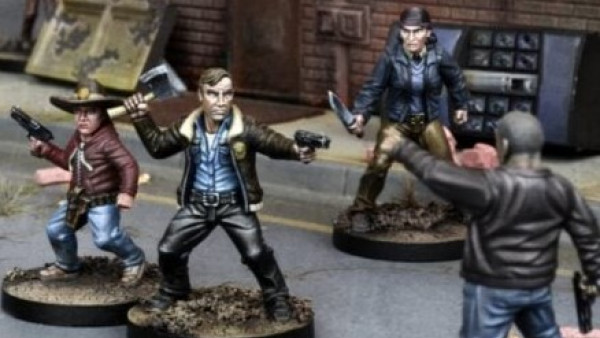


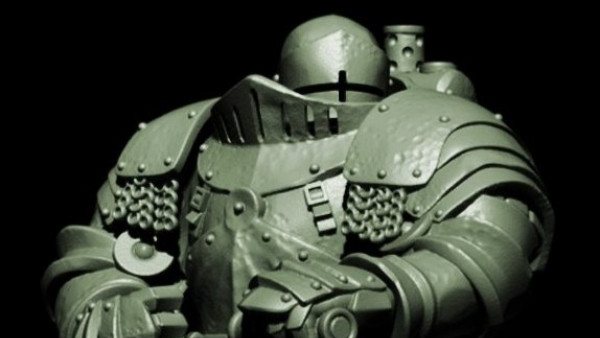
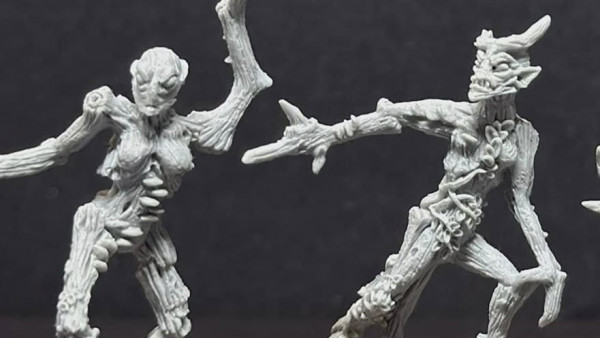
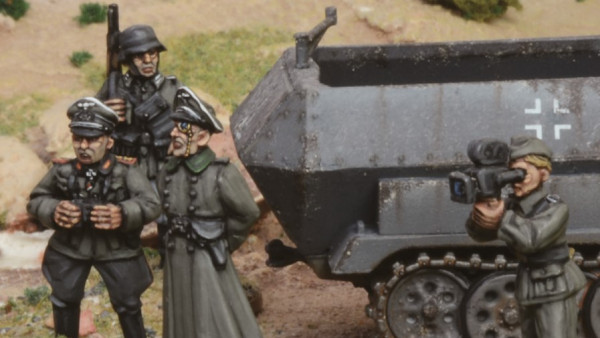


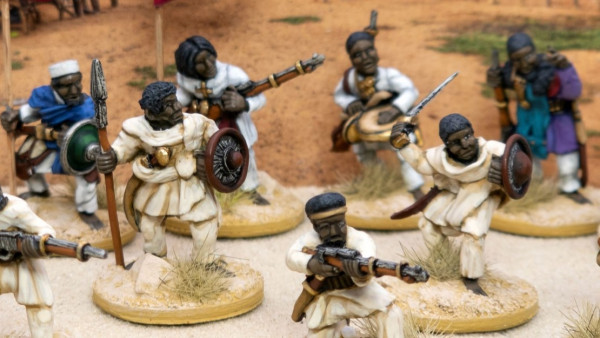

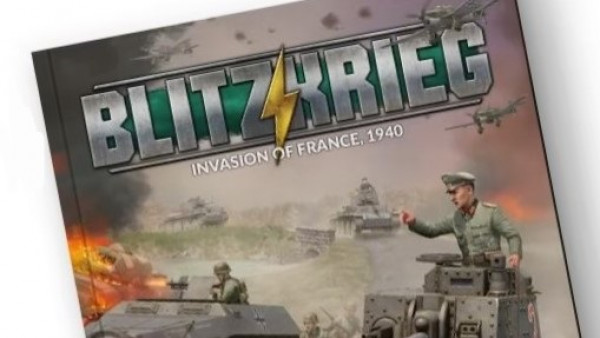
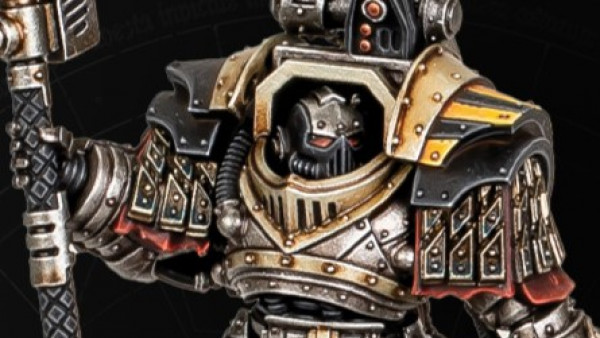
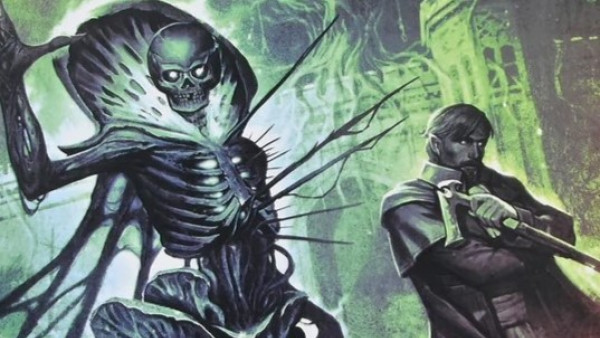
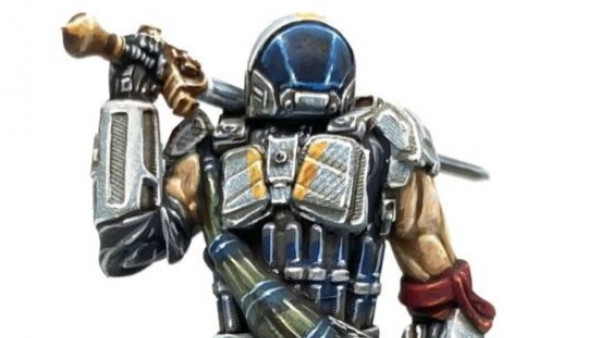

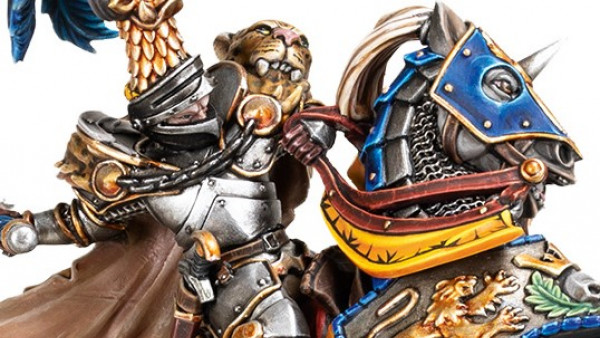

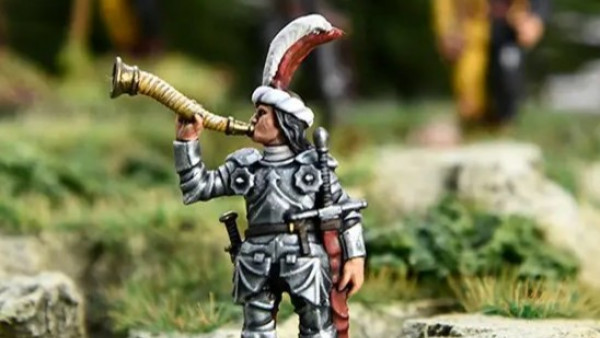

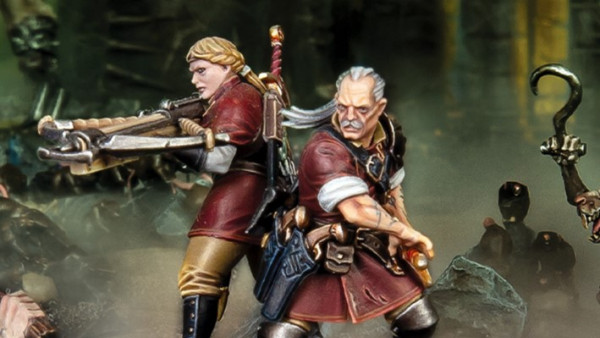
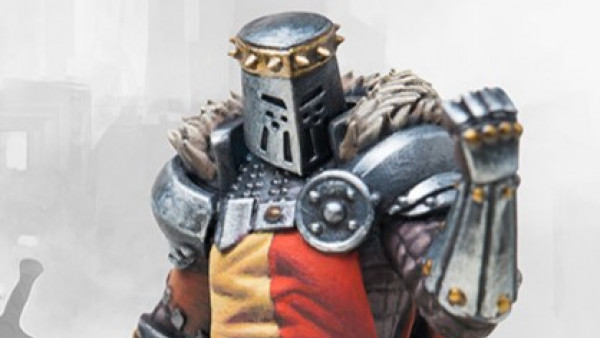


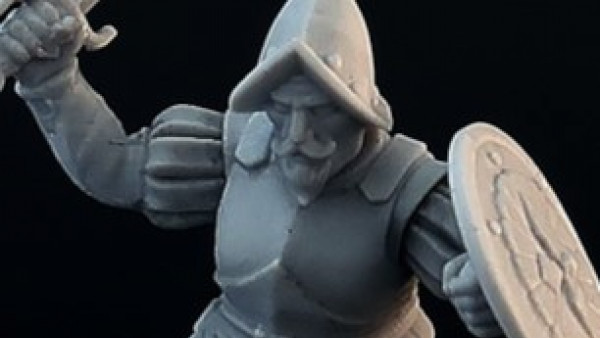

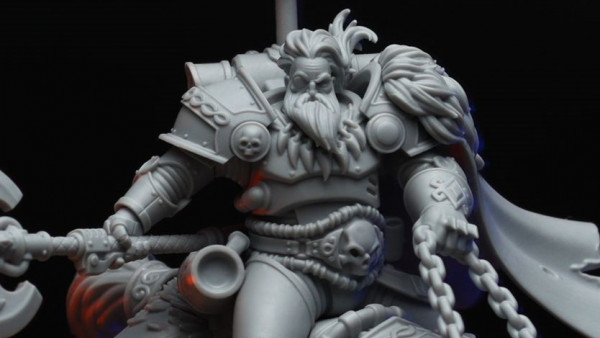

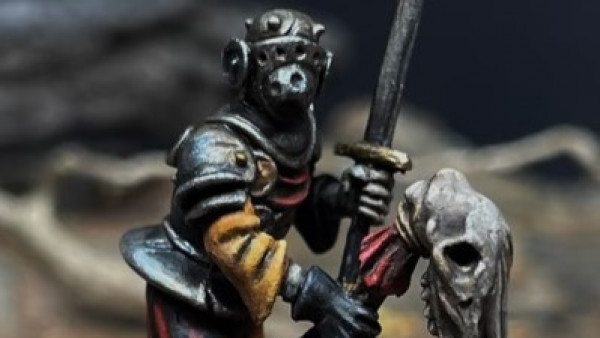


Some people take ‘war-gaming’ to a whole other level…
http://www.dailymail.co.uk/news/article-2873570/Battle-Bulge-70-years-Hundreds-recreate-one-U-S-Army-s-bloodiest-encounters-Nazi-forces.html
Awesome photos. If only the folks who’d made “Fury” had paid this much attention. Not too sure about the writing of the Daily Mail article, though. “Nazi” forces? Really?
I just ignore their rants and look at the great photos 🙂
Oh, absolutely. The photos are epic. 😀
First, Thanks for the mention! I thought I was just having fun blowing Germans off the map, but now I see I’m a vital part in recreating History 🙂 Second, love the picture of the peeking Mark IV! Though I somehow think the American troops would have a slightly different opinion of stumbling across a hidden Panzer. Third, GREAT article. The brief history lesson at the beginning really set the mood and taught me more than the often wrong Battle of the Bulge movies. Also, I like the combination of the different levels of gaming to tell the story. Looking… Read more »
@Gladesrunner is being very modest here . . . she took the photo with the Mark IV. 🙂 I can never get the damned camera to focus that close up.
First, those re-enactment photos are amazing. I’ve seen enough revolutionary and civil war reenactments with my own eyes. Here, the uniforms, equipment and vehicles; captured with that kind of photography, is really cool and cooler than any movie. That modern, colour photo looks like I’m right there. Awesome! Second, I’m also glad to participate in these games. Playing the US in a fighting withdrawal was fun and not extremely difficult. Defense in general, and the fighting withdrawal, are good positions for the less experienced gamer to play against a more experienced one. Even though the German forces, especially artillery was… Read more »
For this who may not be familiar, Panzer Leader came out in ’74 (itself an expansion release for the original PanzerBlitz, 1969-70). So it has a few flaws out of the box, mostly because it was one of the first games of its kind. But once your take the time to retrofit some corrections and enhancements (as @amphibiousmonster mentions), its one of the better WW2 “true tactical” games ever produced. It just needs a little love, first. 🙂
Nice article but.. I need to correct something. It is a common misconception that the upper right photo (the one with the malmedy sign) shows Peiper but that’s not correct. It was taken on 18th Dezember near the kaiserbaracke and Peipers units were never ever near that location.
The photo shows SS-Unterscharführer Ochsner (the guy with the cigarette), an unknown driver and SS-Oberscharführer Persin behind the driver. They were from Kampfgruppe Knittel 🙂
Quick question for you Oriskany. When play the 15mm game how did you enjoy gaming on the narrow roads? Did you find it realistic (frustrating as the attacker) or did you feel the narrow roads gave so much advantage to the defender you had no real chance to win? Playing the defender looks to be more fun on a board made up of narrow roads all leading to the same objective than trying to attack down them.
No doubt about it, @pschwag . Narrow roads and thick tree cover can be a huge pain for an attacker on a 15mm tactical table. However, the attacker can mitigate this effect under the right conditions. A few notes: 1) Lots of trees means lots of cover for an attacking force. As an attacker you can use the thick terrain to your advantage by eliminating “dead ground” over which your units must advance to either spot, engage, or overrun defending positions. 2) Moving armored vehicles THROUGH patches of trees may or may not be allowed depending on the system, but… Read more »
I think this can depend on the scale of the game your playing as well. Larger scaled games woods tend to be less of a problem as regimental and divisional smoke and HE missions tend to make a mess of woods and defenders
Absolutely, @torros . The further you “zoom” out from the foxhole-level battlefield, the less granular terrain becomes. Time scales also expand exponentially, and as you say, assets in firepower become much more powerful. Lastly, the mechanics of many games becomes less about the point-destruction of individual targets and more about breaking down the cohesion of larger formations. All of this can make trees and streams less important, although you do run into new obstacles like rivers, mountain ranges, oceans, and (if you go high enough) politicians. 😀
All this of WW2 is making me think of getting some more 3mm WW2 and finally printing off Fistful of TOE’s.
Although I always find it hard collecting WW2 by myself as I refuse to play German and so I dont usually bother buying it
Personally @pschwag I loved the narrow roads. As the defender I liked the idea of my enemy having to line up in pretty lines along a known route as it makes it a lot easier to set up artillery and bazooka teams 😉
Speaking as one who often causes earthquakes on @oriskany ‘s table, a little bit of kneaded eraser under your most likely to move/tip over terrain will keep it in place. Unless you have a loose table surface like powdered flocking, the eraser should peel right off everything when you are done.
Seriously? Well, damn, dude. Thanks! I have seen that man “credited” as Peiper in that photo in literally dozens of books, I wonder how that misrepresentation has been so widely distributed. We were going to have one of our games feature Schellegruppe Knittel, specifically where he’s initially following Peiper but is ordered by 1st SS LAH commander Wilhelm Mohnke to turn around and re-re-capture Stavelot, so that Knittel, Peiper, and other forward elements of 1st SS Panzer are not cut off. But there is only so much room in these articles and we can run only so many games. Seriously,… Read more »
A few more clearer pictures from that crossroads . . .
http://forum.axishistory.com/download/file.php?id=61397
http://peiper.reibert.info/gallery/other/Malmedy_sign.jpg
Thanks again!
You’re welcome 🙂 Wacht am Rhein and Kampfgruppe Peiper are the two things in WWII I know my way rather well around 🙂
All the Best of luck for you’re series here.
You have done some great work with this. Salute.
Thanks, @mecha82 . 😀 Once again, big thanks to my BOW collaborators amphibiousmonster and gladesrunner.
@torros – an interesting combination of preferences for WW2 gaming. I understand your preference not to play German forces, and (as we’ve discussed before) I completely agree with your preference for early-war rather than late war scenarios. So as a (presumably) early-war Allied player, you must often have the cards stacked against you. 🙂
Sometimes, but it is a challenge. We try and run historical scenarios rather than any point type system so apart from the occasional fght we are usually on the defensive
@amphibiousmonster and I have taken a few swings at Panzer Leader’s special supplement; “Panzer Leader 1940” – dealing specifically with May-June 1940 “Case Yellow / Case Red” battles. Ironically, almost all the PUBLISHED scenarios in that supplement had the French or British on the attack. I think it’s because whenever the Germans are on the offensive in those historical situations, the original designers felt there wasn’t enough of a “game” there to offer players a challenge. So it’s usually local French / British counterattacks like Merdorp-Hannut, Crecy, Stonne, Arras, etc. I can’t say I 100% agree with what these designers… Read more »
Trees are at their most… un-navigable, on slopes. Take it from the guy who lives in the Appalachians. There was, of course, plenty of that in the Ardennes. I only mention because that’s probably a hard place to get mini tree stands to cooperate.
The way we’re doing it, @amphibiousmonster is with my cheap-a$$ homemade bushes. Basically, cut an oval of cardboard, paint one side of it in glue. and mash a bunch of craft-store moss on it. Then, when it comes time for slopes and ridges, etc . . . you can just bend the cardboard bases so your vegetation can follow the contours of the slope to an extent. Detachable craft store trees (with wire “trunks” can then be jammed into the bush, with blue-stick or kneaded eraser to help hold them in place, at an angle so the tree “grows” straight… Read more »
Another cheap way for terrain is to go to a store that sells craft material and see f they have any off cuts of green and brown felt drapes over hills nicely if needed. We use brown for rough and green for woods
That must definitely save on storage space! 🙂
Excellent stuff! Your clearly the battlefield expert. I’ll stick to tank technology and tactics 😉
High praise from the one and only “Tank God!” Thanks very much, and I look forward to the new series discussed on XLBS. 🙂
There’s only one Tank God. 🙂
True enough.
A nice start to the run what many people may not know is that a large forest can be very open under the trees. Tanks can easily travel through a forest that is until they are attacked from the side then they are easy pray as the trees catch the guns as they turn on to the attackers. After all if the Germans were beaten by the environment they would not have tried again. Like the paratroopers attacking Crete the commanders never used them on large aerial assaults again because of the casualties.
Yep, @zorg , forests alone can’t really stop tanks. And sure, the Germans indeed broke through the Ardennes in **roughly** the same zone in 1940 as they did in 1944. Roughly, but not exactly . . . enough to make a difference? There were many differences between the two German attacks that may have helped them “beat the environment” in 1940 but not in 1944. Many of these factors had nothing to do with the environment, like lack of fuel, Allied air superiority, the faster mobilization of Allied reserves for breakthrough containment and then counterattack (certainly NOT the case in… Read more »
I may have to chime in here for a second time, but at the start of the offensiver there was no snow and sub-zero Temperatures in the Ardennes. Until Christmas 1944 no snow had fallen and the Temperatures were around 0-3° Celsius with fog and some rain. You may notice that, when you compare photos and footage taken by the germans (most were taken in the early stages of the offensive) and the USA(most photos were taken in early january). The german ones show no snow whereas the US footage shows plenty of snow. So, until Christmas the conditions were… Read more »
That’s cool, none of our games have had any kind of special “snow rules” restricting vehicle mobility or anything like that. Hey, maybe you can help us out here. In building some of these games, I’m trying to find historical battles that included some of the unit types I know people like to read about or see on the gaming table (case in point: schwere-Panzerjäger Abteilung 506 attached to 12th SS HItlerjugend – included 12 JagdPanthers along with PzJg IV and StG-III – which allowed us to include a JagdPanther in our Engagement 01). I am having a helluva time… Read more »
That will be the films fault, about the tigers? @oriskany dues the game have rules for mud & just use them for snow?
Yeah, Tiger Is are one of those “superstar” units that everyone wants to include in movies, documentaries, books, games . . . I suppose I’m as guilty as anyone, with all this research trying to find a “legitimate” Tiger I Bulge battle. 🙂 No rules for mud in either Axis & Allies, Panzer Leader, etc. There are swamps and marshes, which vehicles usually can’t enter, period. If you wanted to recreate more general “muddy” conditions . . . you can simply “unplug” the road movement rates found in these games, increase fording movement costs for streams and brooks, or subtract… Read more »
You can use a dice roll with say 1.2. (2/3 movement) 3, ½ movement 4.5. (1/3 movement) 6. snow drifts (no movement)
For a miniatures game, certainly, since there are only 20 vehicles or so on the table. I like the randomness since that would mean different patches of the field would have different levels of “muddiness,” and not have to actually track it with “mud” terrain. 🙂
For the larger Panzer Leader games (regiment or brigade sized, hundreds of vehicles with with 120-160 pieces on the board) we would go with something simpler. 😀
What about applying the dice roles to the table before the game on markers face down randomly?
Yeah, that would work for a miniatures Axis & Allies game, but a typical Panzer Leader game has 1200+ hexes on it (the screen captures I use in the articles are greatly zoomed in to show better detail on the units). Kinda tough to put all those “mud thickness” counters on the mapboard. Although … That actually sounds like a great idea for minefields. In Panzer Leader, minefields are always “known,” the defending player just gets to set them up like any other unit. SLIGHTLY unrealistic, but not nearly as much as you’d think (people almost always know where enemy… Read more »
Then the other player may waste their movement point’s to probe the markers identifying which ones are real or dummies?
Sure, either waste movement or — even worse — move units onto an actual minefield and trigger an immediate minefield attack. Minefields can almost never actually destroy a platoon-sized unit, but it pins the unit down, disrupts it, scatters it, and holds it in place. In Panzer Leader it’s called “dispersed,” from which the unit can’t recover right away because it has already moved. The next thing in the turn sequence is usually the enemy’s fire phase, which can much more easily destroy a dispersed unit than one in good order. This is why it’s so important to cover minefields… Read more »
anything to through a spanner in the battle plans is good.
Tiger I’s are indeed rare in the Ardennes. I will check some sources and report back, but iirc there were only few Tiger Is involved in the southern part (Luxembourg) of the offensive.
Panzer IVJ and Panthers did the thick of the fighting.
Awesome, that’s what I thought. I’ll admit that I did include one Tiger I in a game featuring 9th Panzer, fighting on December 26 (future article – based on sPzAbtg 301 FKL, which took 14 operational Tiger Is into the Ardennes . . . but much later in the fight). References state that “it is surprising that 9th Panzer didn’t press its attack against the 2nd US Armored around Humain since they were at nearly full tank strength.” (The Ardennes: Battle of the Bulge – Hugh M. Cole, GPO 1965) So there is a circumstantial **suggestion** that Tiger Is **may**… Read more »
There is the Schwere Panzer Kompanie Hummel (the same unit as in Arnheim) with 8 Tiger I that was subordinated to s.Pz.Abt. 506 in 18th December in 1944, becoming the 4th company.
*there is also the…
I am illiterate and need an edit button!
Schwere Panzerkompanie Hummel was indeed attached as forth company to the 506th Schwere Panzer with its 8 Tiger Is. Infact some of those Tiger Is survived and got back to Germany. One of them destroyed the Pershing near Elsdorf 😉
301 FKL saw some action in Luxembourg with its Tiger Is, but they had only 6 operational during the fighting.
So.. this leaves us with 14 operational Tiger Is in the Ardennes 🙂
Crap. I’m finding different information about what 301 FKL may or may not have done in Ardennes, none of which matters to me because 301 FKL definitively did NOT do what one of our games (to be featured in a future article) says they did. My research was based on records showing 301 FKL as attached to 9th Panzer Division. Hence their minor inclusion in 9th Panzer’s 26 Dec fighting around Marche and Hargimont (Belgium). However . . . http://www.feldgrau.net/forum/viewtopic.php?f=24&t=13721 “… schwere Panzer-Abteilung (Tiger/Fkl) 301 with 29 Tiger Is received word on 15 December 1944 that they were to be… Read more »
It was fun blowing them up…even if they weren’t supposed to be there. Poor Sherman’s get a often deserved bad rep, so I enjoyed giving them a chance to get a little revenge on the mighty Tigers even if it was only pretend.
@gladesrunner – Hmm . . . and those off-board 8-inch howitzer fire missions didn’t hurt either. Actually, I take that back. Hell yeah, they hurt a LOT! 😀
Awesome tip, @drowningharvey . Thanks! 🙂 I’ve clicked around based on the “Hummel” name of the unit you provided and found some corroborating information on 4th Co. Copy/pasting: “It seems as if on the 8 December 1944 the Schwere Panzerkompanie Hummel was attached to the Schwere Panzerabteilung 506 as it’s fourth company. At the beginning of the offensive the Schw. Pz. K. Hummel had eight Tiger I tanks. Apparently they were under the command of the 7. Armee and not, as I would have thought, under the 6. Panzerarmee. They see action from the 21st of December on, but in… Read more »
About two years ago I played the 503rd during operation Goodwood. Well the two companies that weren’t bombed and flipped over near Cagny. A lot of Shermans died that day and I was never able to recreate the famous scene if an Irish Sherman ramming the Koenig. Well not on the PL tabletop. But I did with my 10mm minis.
I remember that photo and that “miniatures recreation.” 😀
“Don’t tell **US** that a Sherman can’t take out a King Tiger! We just don’t use the GUN to do it!”
You can always count on the Irish when madness is involved.
that’s the Celtic blood for you.
If my info at the time was correct, the 503 was located in the vicinity of Leibstandarte, 21st Panzer and the afore mentioned 12ss, Hitler Jugend. But they (12thSS) were pulled offline about a week before Goodwood for refit and for preparation against a still-feared second landing to the Northeast.
Yeah, these “schwere Panzer Abteilung” (heavy tank detachments) were numbered 501 – 512 I think. There were also some strange ones like 301 FKL, 424, Grossdeutschland, the “Hummel” company @drowningharvey mentions, etc. There may be have been more, I can’t remember off the top of my head. The SS had their own set, of course, originally numbered 101, 102, 103 . . . etc. . . until they were re-equipped with Tiger IIs instead of Is, when they were re-numbered 501, 502, same as the Wehrmacht sPzAbtg. Keep track of German units is NEVER confusing, though. 🙂 On another topic,… Read more »
That looks a little bit more like my US set up when I ran that in 2010. With less accurate units.
There was a much hotter fight for the Panzer Leader “town” of Artain and it’s bridge. Directly east of the “Real” St Vith, as opposed to the northeasterly defense in this past game.
So of a more “forward” defense? That must have been a nightmare. Just setting up the Germans in that very narrow deployment zone was annoying enough. Actually having to fight through all that must have been a pain. I don’t know why the original designers for that scenario (Panzer Leader Situation 13) didn’t just have the Germans enter on the east end of the map board. By forcing the Germans to deploy ON the table, it actually causes a rules paradox (general rule: No side can ever set up with other units in LOS of enemy units).
My US deployment was a little too greedy. Using those “out of the box” set up rules, I set up WAY forward to make the German set up even more nightmare-ish. However, The Germans did set up close enough to lauch some “CAT” (Close assault tactics) attacks on the first turn. Virtually unheard of in that system.
Damn, @amphibiousmonster . CATs (Close Assault Tactics) on foot on the first turn? That’s some crazy American Revolution-style s*** there.
“Fix Bayonets!”
And there’s nothing wrong with a forward defense. I think that’s the reason the game (and others like it) include that rule, to the defender can basically “push back” enemy approach routes with patrols, pickets, OPs, sentries, that kind of thing. Of course, it can be overdone if too many of your units get swamped in the enemy’s opening assault.
I recall many slow stream crossings….
Great, really interesting article, and excellent and fascinating history from various people in the comments too.
Really looking forward to the next one!
Thanks, @angelicdespot . We’ve always suspected there was an undercurrent of true rivet-counting, history-loving, hex-crawling, bookworm grognards creeping around in the basement of the BoW community! 😀 Glad you liked the article and hope you like the next one.
Thanks again so much! These posts always get me pumped up.
I really want to dive into Historical the people around just play 40k though, at least I can get caught up in my knowledge of history.
Historical situations are very good for Solitaire play. The conditions of the history help dictate the approaches of each side and can help with anti-biased decision making.
Agree with @amphibiousmonster , @leoleez . Solitaire can work well for historical games, especially of you’re not sure of the design. Set up the best game you can, play it out using historical choices, take “your hands off the dice,” so to speak (just let the chips fall where they may) . . . and if the game produces a result somewhat like the history, you have a winner. Now you can start “taking off the training wheels” and trying new solutions, maneuvers, tactics, or adding / subtracting units (what if Blucher’s Prussians had never arrived at Waterloo?). We’re also… Read more »
Vassel or Cyberboard or something similar would be the way to go here I think
I’m not familiar with Cyberboard but I have heard lots of great things about Vassal. My only reservation would be about house rules or scenario design, custom units and custom maps, that kind of thing. Depending on how detailed and precise players want to get with the historical aspect of a game, they would probably have to create a lot of this material themselves, which means they’d need “next level” knowledge of the tool (perhaps programming level?) and administrative access. Playing on these Excel boards via shared web space and phone conference is a admittedly little cumbersome . . .… Read more »
Ok, I am going to go like: “OMG I am so excited about this I cannot wait to read more”. 🙂
And to quote the classic: @oriskany “Absolutely, fabulous stuff”. 😉
Hey, thanks @yavasa . I had some help this time on the gaming side from Amphibiousmonster and Gladesrunner, and I’m happy to say we have some more great stuff coming out in the rest of the series. This should run well into January, just like the actual Battle of the Bulge did 70 years ago. 🙂
Glad you like it!
Great job @amphibiousmonster and @gladesrunner 🙂
Thanks @yavasa , @oriskany does all the hard work and research, we get the fun job of playing.